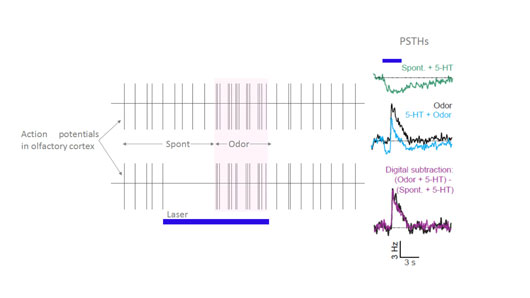Serotonin is an important brain chemical implicated in a wide variety of behavioral, cognitive and emotional processes and is an important pharmacological target in the treatment of many psychiatric and neurological diseases. In addition, some psychoactive drugs like LSD and Extasy also target the serotonergic system. However, relatively little is known about its actual role in the healthy brain.

Figure: Serotonergic photostimulation results in suppression of spontaneous, but not odor, evoked neuronal activity in the primary olfactory cortex. (Left) Action potentials recorded in the olfactory cortex in the presence (bottom) and absence (top) of serotonergic stimulation respectively. Note that while spontaneously occurring action potentials are suppressed by serotonin the odor evoked activity (pink box) is unaltered. (Right) Peri-event time histograms (PSTHs) for each condition computed from all the recorded neurons: top: suppression of spontaneous neuronal activity, middle: activity during odor presentation in the absence (black) and presence (blue) of serotonin stimulation, respectively. Digital subtraction of the photostimulation only from the photostimulation + odor condition yields a PSTH identical to the odor only condition.
Under normal conditions, sensory neurons, such as the ones located in the primary olfactory cortex, are driven by a combination of bottom-up sensory inputs originating in the environment, and top-down signals that reflect, among other things, predictions regarding the nature of the expected input. Our results show that specific activation of serotonergic neurons in the brainstem dorsal raphé nucleus of mice using optogenetic tools massively influences the activity of neurons in the primary olfactory cortex. When Channelrhodopsin expressing serotonergic neurons were stimulated using an implanted fiberoptic coupled to a blue laser the sponataneous activity of neurons in the olfactory cortex was dramatically reduced on a rapid (1 second) timescale. On the other hand, when serotonergic stimulation was performed with a simultaneously presented sensory stimulus –an odor– no effect could be seen between the odor response recorded in the absence, and presence, of the stimulus, respectively.
Our results show that serotonin can suppress internally generated or feedback activity while leaving feed-forward information from the sensory periphery unaltered. When serotonin levels are high these neurons stop responding to the top-down inputs, but maintain the raw sensory input processing intact. This biasing effect, we hypothesize, has significant implications for olfactory perception and learning. Namely that under conditions of high uncertainty, prediction errors result in the elevation of serotonin levels, which in turn mediate unlearning of old, failing models and new learning of better ones.
Reference
Optogenetic activation of dorsal raphe serotonin neurons rapidly inhibits spontaneous but not odor-evoked activity in olfactory cortex. Eran Lottem*, Magor L. Lőrincz* and Zachary F. Mainen (2016) The Journal of Neuroscience, 36(1): 7-18; doi: 10.1523/JNEUROSCI.3008-15.2016. *equal contribution


































